Key takeaways
- Panna cotta is a classic Italian dessert characterized by its creamy texture, made from cream, sugar, and gelatin.
- Key ingredients for a successful panna cotta include high-quality heavy cream, carefully measured sugar, and properly bloomed gelatin.
- Flavor variations and simple toppings, such as fresh berries or a light drizzle of honey, enhance the panna cotta experience without overshadowing its natural richness.
- Presentation and serving methods can elevate the enjoyment of panna cotta, transforming it from a simple dessert into a delightful event.
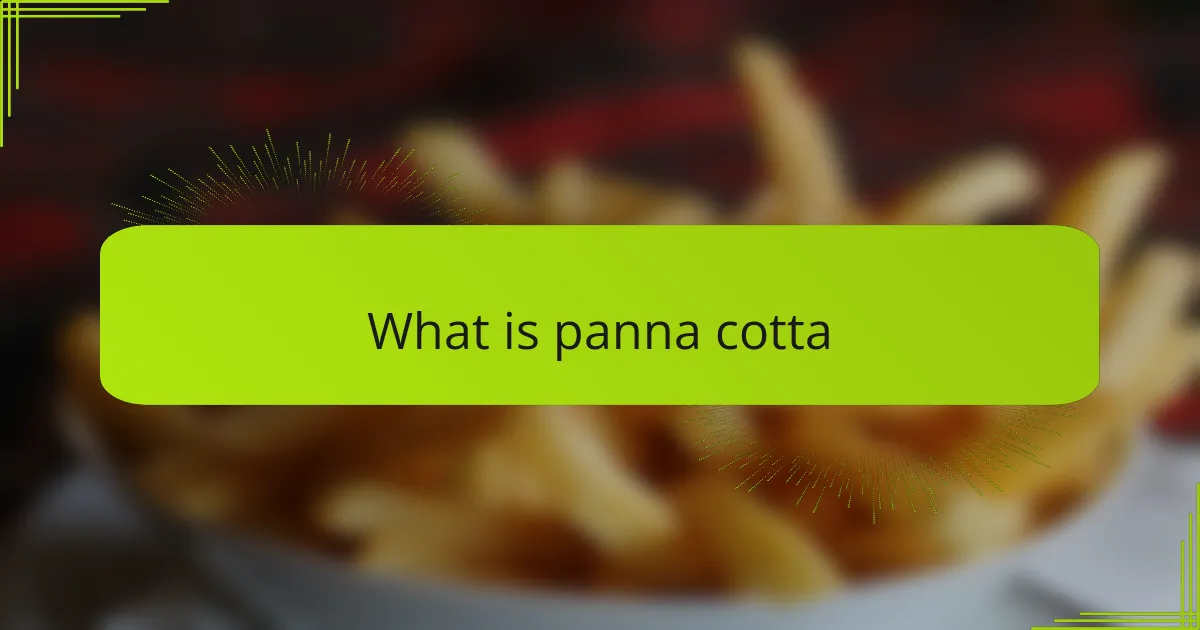
What is panna cotta
Panna cotta is a classic Italian dessert that literally means “cooked cream.” At its core, it’s a silky, smooth custard made by gently heating cream, sugar, and gelatin until perfectly set. I’ve always admired how simple ingredients come together to create something so luxuriously creamy.
What makes panna cotta special to me is its delicate texture—soft, yet holding its shape just right. Have you ever tasted a dessert that melts effortlessly on your tongue? That’s exactly the sensation panna cotta delivers every time, making it feel like a subtle celebration in each bite.
In my experience, pannacotta’s beauty lies not only in its flavor but also in its versatility. Whether plain or paired with fresh fruits or a drizzle of caramel, it feels elegant yet unpretentious—something anyone can enjoy without fuss or complication.
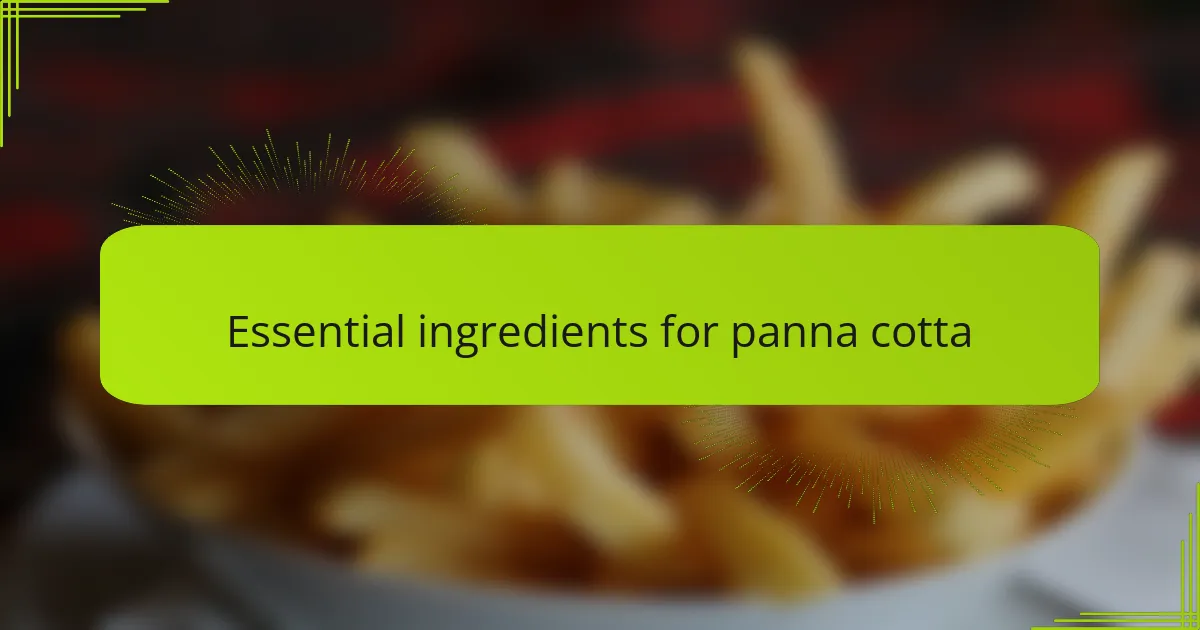
Essential ingredients for panna cotta
At the heart of every panna cotta lies cream—lots of it. I always reach for heavy cream because its richness is what gives the dessert that luscious, velvety mouthfeel I crave. Without a good quality cream, panna cotta just won’t have that indulgent texture that makes you want to savor every spoonful.
Sugar plays a quiet but essential role too. I remember the first time I made panna cotta without considering sugar carefully; the result was a bit flat, lacking that gentle sweetness that balances the richness of the cream. Just the right amount of sugar brings harmony—never overpowering, just enough to enhance the cream’s natural flavor.
Then there’s gelatin, the unsung hero that holds it all together. When I first dealt with gelatin, I found it tricky—too little and the panna cotta wouldn’t set, too much and it became rubbery. Over time, I learned to trust the right ratio, allowing the dessert to set perfectly firm yet still soft enough to jiggle invitingly on the plate. Have you ever experienced that perfect wobble of panna cotta? It’s quite satisfying.
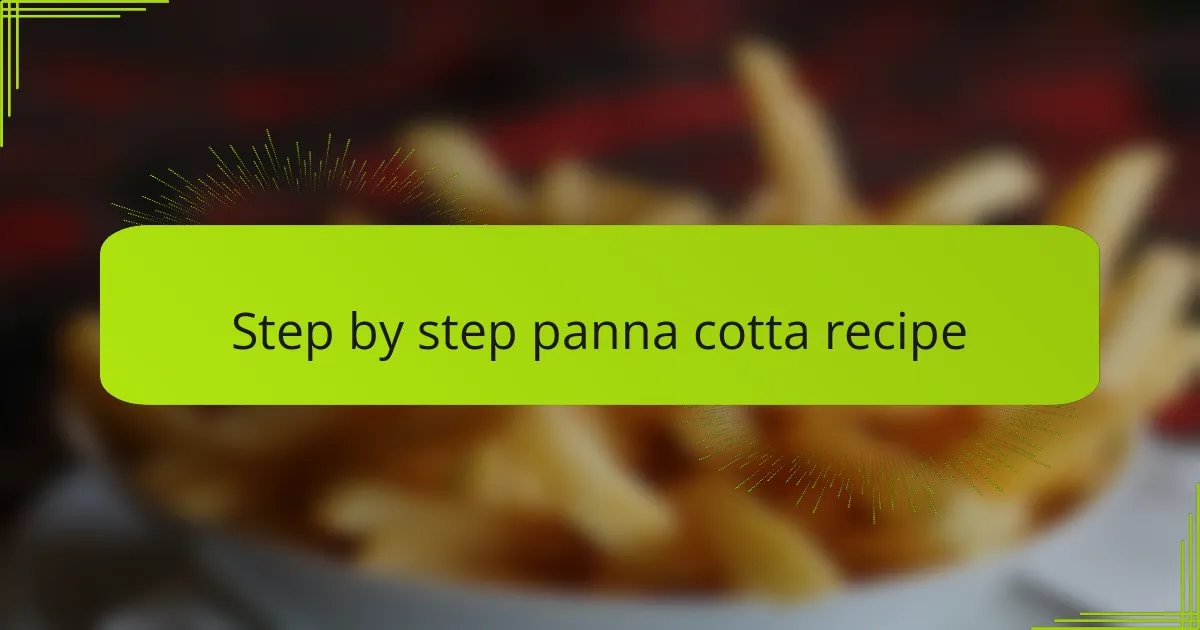
Step by step panna cotta recipe
Getting the panna cotta just right is a bit of an art, and I’ve found that taking it step by step really helps. First, I slowly warm the cream with sugar, stirring gently so everything dissolves without boiling away that delicate richness. Have you ever worried about burning the cream? I used to, but keeping the heat low changes everything—it lets the cream develop a subtle sweetness that’s hard to beat.
Once the cream and sugar mingle beautifully, I sprinkle gelatin over a little cold water to let it bloom—that’s when it absorbs the liquid and gets soft. I always make sure the gelatin dissolves entirely by stirring it into the warm cream mixture, which helps avoid any unpleasant clumps. It’s satisfying to see how this simple step transforms the liquid into a set dessert later; the texture is what seals the deal for me.
Pouring the mixture into molds is where patience really pays off. I usually let mine chill in the fridge for at least four hours, but sometimes I sneak a peek after two just to check that wobbly goodness I love. Have you ever felt that excitement waiting for a dessert to set? It’s like anticipating a little reward, and when the panna cotta finally holds its shape, it’s a moment of pure joy every time.
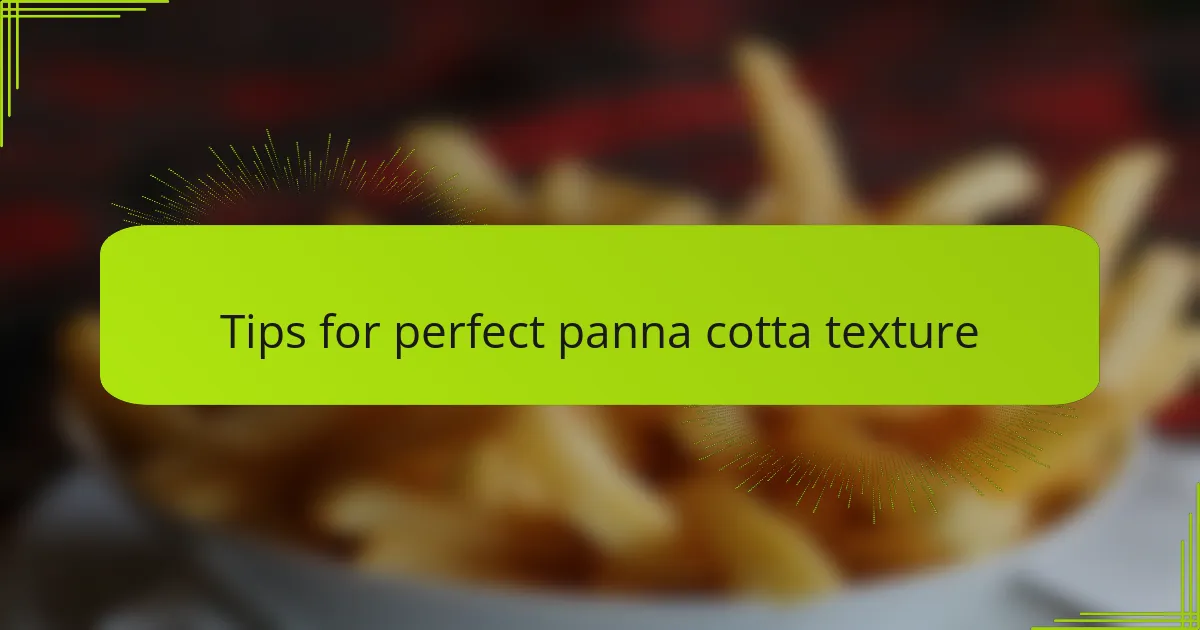
Tips for perfect panna cotta texture
One key trick I’ve learned for that perfect panna cotta texture is not rushing the gelatin blooming process. I remember the first time I skipped this step—I ended up with uneven spots and a less smooth finish. Taking those few extra minutes to let the gelatin fully absorb the cold water really makes a difference in achieving that delicate, silky set.
Another thing that’s helped me is being careful not to overheat the cream mixture. Too high a temperature can break down the gelatin’s setting power, resulting in a panna cotta that’s too soft or even watery. Keeping the heat low and gentle, almost like I’m coaxing the flavors out slowly, has consistently given me that luscious, melt-in-the-mouth feel I aim for.
Have you ever noticed how chilling time changes everything? I’ve found that four to six hours in the fridge is ideal—not too short to leave it wobbly, and not so long that it becomes overly firm. Sometimes, I even let it chill overnight to develop a texture that’s just right, where it’s firm enough to hold its shape but still gives way easily with your spoon. Isn’t that little wobble exactly what makes panna cotta so irresistible?

Flavor variations and toppings
One of the things I love most about panna cotta is how easily you can play with flavors. I often add a twist like vanilla bean pods or a splash of espresso to the cream before setting it — both create a rich depth that feels so indulgent. Have you ever tried infusing your panna cotta with lavender or citrus zest? It’s a small step that transforms the dessert into something unexpectedly elegant.
When it comes to toppings, I usually opt for simplicity that lets the panna cotta shine. Fresh berries, like ripe raspberries or juicy blueberries, add a burst of freshness and a pleasant tart contrast to the creamy base. Sometimes, I drizzle a little honey or a tangy berry coulis on top—these subtle touches bring the whole experience to life, creating layers of flavor that keep surprising you with each bite.
One topping that caught me by surprise was toasted nuts, particularly pistachios or almonds. The crunch against that smooth, silky panna cotta adds an irresistible texture contrast. It’s fascinating how just a sprinkle can turn a soft, delicate dessert into something with a little more character and excitement. Have you tried mixing textures in your desserts? It definitely elevates the enjoyment for me.

How I enhanced my panna cotta experience
Enhancing my panna cotta experience started with small tweaks that made a big difference. I remember once adding a touch of freshly grated nutmeg to the cream; that subtle warmth gave the dessert an unexpected cozy depth. Have you ever caught yourself savoring a dessert not just for taste but for the comforting memories it stirs? That’s exactly what happened to me.
Texture-wise, I began experimenting with chilling times beyond the usual four hours. There was one occasion when I left my panna cotta overnight, and waking up to that perfectly set yet silky custard felt like a luxurious breakfast treat. Don’t you find that patience in the kitchen often rewards you far beyond the effort? It’s these little moments that truly enhanced my enjoyment.
Finally, presenting the panna cotta differently made the experience more joyful. Instead of simple molds, I tried serving it in small glasses layered with fresh fruit compotes and a sprinkle of toasted pistachios. The combination of creamy, fruity, and crunchy became a delightful journey for my palate. Have you ever noticed how changing the way you serve a dessert can make eating it feel like an event? For me, that shift turned panna cotta from a simple dessert into a memorable experience.
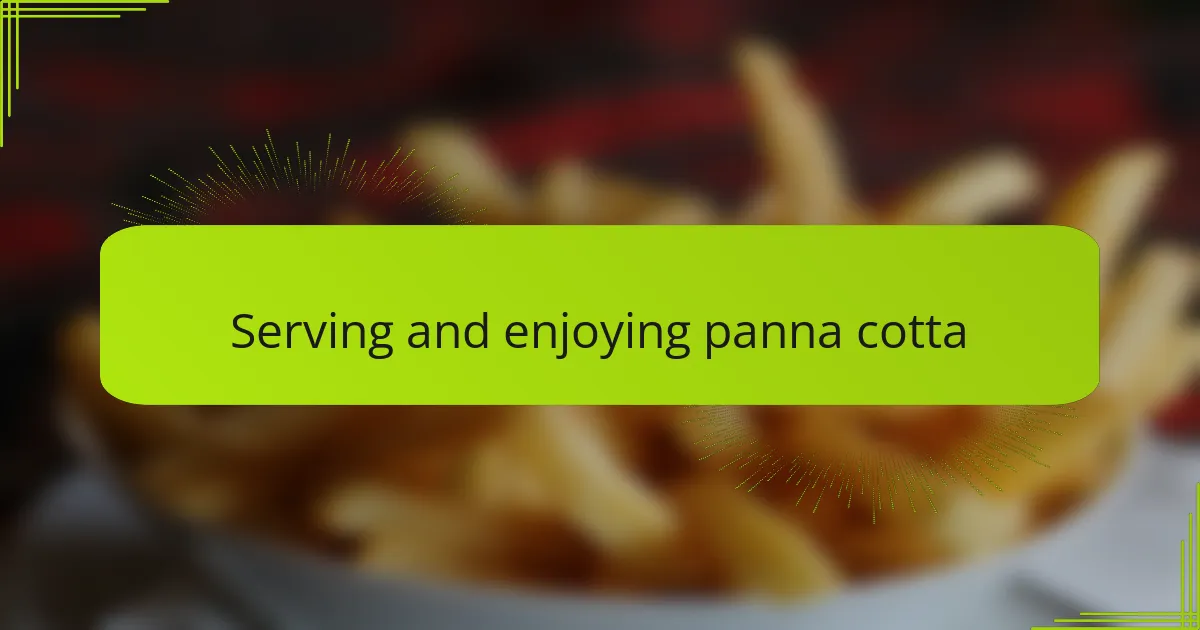
Serving and enjoying panna cotta
Serving panna cotta is such a special moment for me—I love how effortlessly elegant it looks when gently unmolded onto a chilled plate. There’s a quiet thrill in seeing that perfect, delicate wobble before you take the first bite. Have you ever felt your anticipation build just by the sight of a dessert that seems too beautiful to eat?
I often enjoy my panna cotta with a simple garnish, like a few fresh berries or a drizzle of honey, letting the creamy texture take center stage. Sometimes, I add a sprig of mint for a touch of freshness, which adds not only flavor but a lovely visual contrast. Don’t you find that little touches like these make eating dessert feel a bit more celebratory?
Eating panna cotta is about savoring the moment—it’s soft, silky, and melts almost like a luxurious whisper in your mouth. I like to pause between bites, really appreciating how the creamy richness lingers and the subtle sweetness comforts me. Isn’t it amazing how a simple dessert can offer such a rich, sensory experience?




